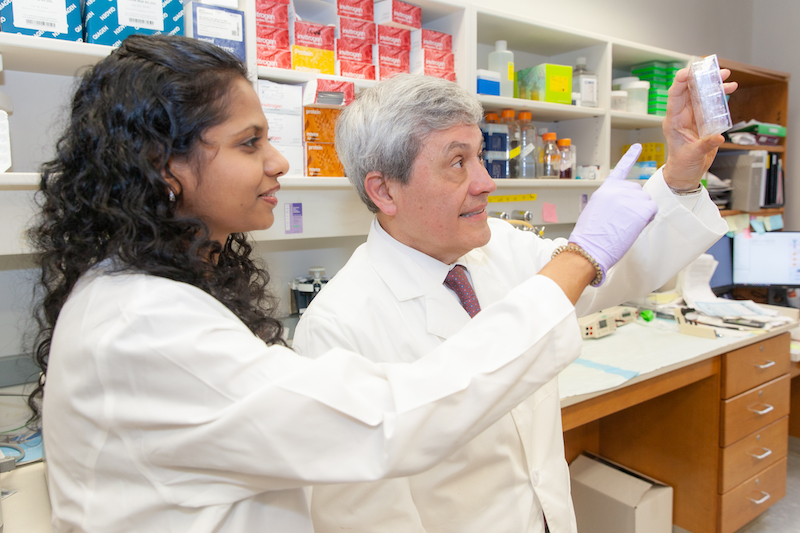Researchers uncover two-drug combo that halts the growth of cancer cells
Discovery could counter resistance to promising new breast cancer therapy

DALLAS – Jan. 23, 2020 – UT Southwestern Simmons Cancer Center researchers have discovered a two-drug combo that halts the growth of cancer cells that carry HER2 mutations.
The findings, published today in the journal Cancer Cell, were prompted by the observation that, after an initial response, patients with cancers harboring HER2 mutations eventually develop resistance to a promising new cancer drug currently in clinical trials.
The scientists found that another drug, already on the market, counters that resistance and blocks the cancer, thereby providing the basis for a novel drug combination against cancers with mutations in the HER2 gene.
Dhivya Sudhan, Ph.D., a postdoctoral research fellow in the Harold C. Simmons Comprehensive Cancer Center, and collaborators evaluated data from a molecularly guided trial where patients with tumors with HER2 mutations were treated with the HER2 inhibitor neratinib. In this study, patients’ cancers were sequenced as the disease progressed during treatment. Based on this analysis, Sudhan discovered in the laboratory that an effective way to offset eventual resistance to neratinib is with everolimus, a TORC1 inhibitor commonly used to treat other types of breast cancer.
“This finding may give clinicians an effective response to neratinib resistance. That could make a real difference for patients with breast, ovarian, lung, and other cancers harboring HER2 mutations,” says Carlos L. Arteaga, M.D., Director of the Simmons Cancer Center at UT Southwestern and corresponding author of the study.
HER2 mutations have long been identified as a key driver in breast and other cancers. The authors of this study zeroed in on a signaling network driven by TORC1, which they showed is the pathway through which HER2-mutant cancers become neratinib-resistant.
“We consistently noted activation of TORC1 signaling as a mechanism of resistance to neratinib across different types of HER2-mutant cancers. Different cancer types used different strategies to escape neratinib, but they all converged on TORC1 signaling,” Sudhan says.
In addition to studying tumor sequencing data from HER2-mutant cancer patients across the country who are in clinical trials for neratinib, Sudhan also studied neratinib-resistant cells and tumors that continue to live and grow in the laboratory.
The sequencing of the patients’ cancer before and during the clinical trial showed that some patients already had a mutation that could activate the TORC1 pathway. Others would develop it eventually, but they could benefit from everolimus which is currently used as a TORC1 inhibitor to address the other roles TORC1 plays in cancer. Everolimus would allow the patient to continue benefiting from neratinib’s inhibition of HER2.
Sudhan says the combination of neratinib and everolimus worked in cell lines, organoids established from patient-derived tumors, and in mice harboring HER2 mutant tumors. The next step will be testing this two-drug combo in humans.
Other authors were Angel Guerrero-Zotano, M.D., of the Department of Medicine, Vanderbilt University Medical Center, Nashville, Tennessee; Helen Won, M.S., of Memorial Sloan Kettering Cancer Center, New York; Paula González Ericsson, M.D., of the Comprehensive Cancer Center, University of New Mexico, Albuquerque, New Mexico; Alberto Servetto, M.D., of the Simmons Cancer Center at UT Southwestern; Mariela H. Rosario, M.D., of the Simmons Cancer Center at UT Southwestern; Dan Ye, M.D., of the Simmons Cancer Center at UT Southwestern; Kyung-min Lee, Ph.D., of the Simmons Cancer Center at UT Southwestern; Luigi Formisano, M.D., Ph.D., of the Department of Medicine, Vanderbilt University Medical Center; Yan Guo, Ph.D., of the Comprehensive Cancer Center, University of New Mexico; Qi Liu, Ph.D., of the Center for Quantitative Sciences, Vanderbilt University Medical Center; Lisa N. Kinch, Ph.D., of UT Southwestern; Monica R. Brewer, Ph.D., of the Department of Medicine, Vanderbilt University Medical Center; Teresa Dugger of the Department of Medicine, Vanderbilt University Medical Center; James Koch, M.S., of the Department of Medicine, Vanderbilt University Medical Center; Michael J. Wick, Ph.D., of the START Center for Cancer Care, San Antonio; Richard E. Cutler Jr., Ph.D., of Puma Biotechnology Inc., Los Angeles; Alshad S. Lalani of Puma Biotechnology Inc.; Richard Bryce of Puma Biotechnology Inc.; Alan Auerbach, M.S., of Puma Biotechnology Inc.; and Ariella B. Hanker, Ph.D., of UT Southwestern.
Cutler, Lalani, and Auerbach are employees of and hold ownership interest (including patents) in Puma Biotechnology Inc. Guerrero-Zotano has received research and travel grants from Pfizer. Hanker receives research grant support from Takeda. Arteaga is a consultant to Puma Biotechnology. He receives or has received research grants from Puma Biotechnology, Pfizer, Lilly, Bayer, Takeda, and Radius; holds stock options in Provista and Y-TRAP; serves or has served in an advisory role to Novartis, Merck, Lilly, Symphogen, Daiichi Sankyo, Radius, Taiho Oncology, H3 Biomedicine, OrigiMed, Puma Biotechnology, and Sanofi; and reports Scientific Advisory Board remuneration from the Komen Foundation.
The study was funded by the Simmons Cancer Center (P30 CA142543, 440), the Cancer Prevention & Research Institute of Texas (RR170061), the National Cancer Institute Breast SPORE (P50 CA098131), the Vanderbilt-Ingram Cancer Center (P30 CA68485), Susan G. Komen Breast Cancer Foundation (SAC100013), the Breast Cancer Research Foundation (R01CA224899), and the Susan G. Komen Postdoctoral Fellowship (PDF17487926). The authors acknowledge the assistance of the UT Southwestern Tissue Resource supported by the National Cancer Institute (5P30CA142543).
About UT Southwestern Medical Center
UT Southwestern, one of the premier academic medical centers in the nation, integrates pioneering biomedical research with exceptional clinical care and education. The institution’s faculty has received six Nobel Prizes, and includes 22 members of the National Academy of Sciences, 17 members of the National Academy of Medicine, and 14 Howard Hughes Medical Institute Investigators. The full-time faculty of more than 2,500 is responsible for groundbreaking medical advances and is committed to translating science-driven research quickly to new clinical treatments. UT Southwestern physicians provide care in about 80 specialties to more than 105,000 hospitalized patients, nearly 370,000 emergency room cases, and oversee approximately 3 million outpatient visits a year.
